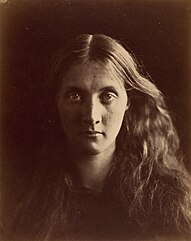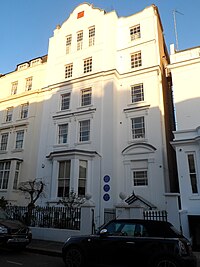Virginia Woolf
| Virginia Woolf | |||
|---|---|---|---|

Virginia Woolf 1902; photograph by George Charles Beresford
| |||
| Born | Adeline Virginia Stephen 25 January 1882 South Kensington, London | ||
| Died | 28 March 1941 (aged 59) Lewes, Sussex, England | ||
| Cause of death | Suicide by drowning | ||
| Residence | Monk's House, Rodmell, East Sussex | ||
| Nationality | British | ||
| Alma mater | King's College London[1] | ||
| Occupation | Novelist, essayist, publisher, critic | ||
| Spouse(s) | Leonard Woolf (m. 1912–1941) | ||
| Parent(s) |
| ||
| Relatives | |||
| Signature | |||
 | |||
She was born in an affluent household in South Kensington, London, attended the Ladies' Department of King's College and was acquainted with the early reformers of women's higher education. Having been home-schooled for the most part of her childhood, mostly in English classics and Victorian literature, Woolf began writing professionally in 1900. During the interwar period, Woolf was a significant figure in London literary society and a central figure in the influential Bloomsbury Group of intellectuals. She published her first novel titled The Voyage Out in 1915, through her half-brother’s publishing house, Gerald Duckworth and Company. Her best-known works include the novels Mrs Dalloway (1925), To the Lighthouse (1927) and Orlando (1928), and the book-length essay A Room of One's Own (1929),[4] with its dictum, "A woman must have money and a room of her own if she is to write fiction."
Woolf became one of the central subjects of the 1970s movement of feminist criticism, and her works have since garnered much attention and widespread commentary for "inspiring feminism", an aspect of her writing that was unheralded earlier. Her works are widely read all over the world and have been translated into more than fifty languages. She suffered from severe bouts of mental illness throughout her life and took her own life by drowning in 1941 at the age of 59.
Contents
[hide]- 1 Life
- 2 Work
- 3 Views
- 4 Modern scholarship and interpretations
- 5 In popular culture
- 6 Legacy
- 7 Family trees
- 8 Notes
- 9 References
- 10 Bibliography
- 11 External links
Life[edit]
Family of origin[edit]
- George (5 March 1868 – 1934), a senior civil servant, married Lady Margaret Herbert 1904
- Stella (30 May 1869 – 1897), died aged 28[b]
- Gerald (29 October 1870 – 1937), founder of Duckworth Publishing, married Cecil Alice Scott-Chad 1921
The widowed Julia Duckworth knew Leslie Stephen through her friendship with Minny's older sister Anne (Anny) Isabella Ritchie and had developed an interest in his agnostic writings. She was present the night Minny died[24] and added Lesley Stephen to her list of people needing care, and helped him move next door to her on Hyde Park Gate so Laura could have some companionship with her own children.[25][26][27][5] Both were preoccupied with mourning and although they developed a close friendship and intense correspondence, agreed it would go no further.[d][28][29] Lesley Stephen proposed to her in 1877, an offer she declined, but when Anny married later that year she accepted him and they were married on March 26, 1878. He and Laura then moved next door into Julia's house, where they lived till his death in 1904. Julia was 32 and Leslie was 46.[23][30]
Their first child, Vanessa, was born on May 30, 1879. Julia, having presented her husband with a child, and now having five children to care for, had decided to limit her family to this.[31] However, despite the fact that the couple took "precautions",[31] "contraception was a very imperfect art in the nineteenth century"[32] resulting in the birth of three more children over the next four years.[e][33][12][34]




No comments:
Post a Comment